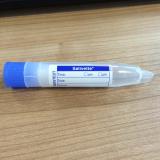Test Directory
Oral Fluid Drugs of Abuse screen
Containers - Adult

Sarstedt Salivette oral fluid collection device
|
Volume Range
50µL |
Containers - Child

Sarstedt Salivette oral fluid collection device
|
Volume Range
50µL |
Reference ranges
Not detected
Laboratory Site
Old Dalkeith Road
Edinburgh
EH16 4SA
Sample storage arrangements
Refrigerate until transported to laboratory
Special instructions for collection
How to collect saliva using the Sarstedt Salivette device:
1) Remove the top cap of the tube to expose the round sponge. Do not remove the holder that the sponge sits in.
2) Place the sponge in your mouth by tipping the tube so the sponge falls into your mouth. Do not touch the sponge with your fingers.
3) Keep the sponge in your mouth. Very gently chew and roll the sponge around your mouth for 1-2 minutes. Spit the sponge back into the inner sleeve of the tube. Do not touch the sponge with your fingers.
4) Replace the cap. Make sure cap is on tightly.
5) Label the Salivette tube with the patient's full name, date of birth and date/time of collection. Complete all details on the request form, including full name, date of birth, CHI or registration number, requesting location and clinician, time/date of collection and specimen type, requesting a drug screen.
How to request
Oral fluid drugs of abuse can be requested on TRAK, GP ICE or using a standard blood science request form. Indicate the sample type as oral fluid.
Anticipated turnaround
7 days
What happens if the result is positive or abnormal
Drugs are analysed by a specific tandem mass spectrometry method. Drugs are validated by the presence of quantifying ions and qualifying ions. Both of these must have a retention time that matches each other and the corresponding deuterated internal standard. Drugs at a level above its threshold level are reported as positive.
General additional information
The report will contain 8 core drugs:
- Opiate group (morphine, codeine, 6-mono-acetyl morphine (heroin metabolite), dihydrocodeine, oxycodone - individual drugs reported only when the group is positive)
- Amphetamine
- Cocaine (benzoylecgonine is also measure but not reported - it's presence confirms that cocaine has been metabolised by the liver)
- Methadone
- Benzodiazepine group (diazepam, temazepam, oxazepam, nitrazepam, nordiazepam (metabolite of diazepam and chlordiazepoxide - individual drugs are not reported)
- Gabapentin
- Pregabalin
- Buprenorphine
The following drugs are only reported when positive (ie. if not listed, negative status can be assumed):
MDMA (ecstasy), Methamphetamine, Tramadol.
'Street' benzodiazepines including: Alprazolam (Xanax), Etizolam, Bromazolam
Drug threshold levels:
Morphine: 20µg/L when the only drug present, 10µg/L when 6MAM is positive. Morphine is a metabolite of both codeine and 6MAM and it's presence with these supports the consumption of codeine or heroin. Morphine only is also compatible with MST and other morphine preparations.
6MAM (heroin metabolite): 13µg/L
Codeine: 20µg/L (compatible with codeine but also acetyl codeine found in heroin)
Dihydrocodeine: 20µg/L
Oxycodone: 20µg/L (compatible with oxycodone, oxynorm, oxycontin)
Amphetamine, methamphetamine, MDMA: 30µg/L
Cocaine: 13µg/L The presence of cocaine metabolite (benzoylecgonine) indicates that cocaine has been consumed.
Methadone: 20µg/L
Gabapentin, Pregabalin, Tramadol: 40µg/L
Buprenorphine: 1µg/L. Note very high levels are seen if the sample is collected within a short time after sublingual administration of buprenorphine. Half life of buprenorphine varies widely from 2-24 hrs. Negative results can be seen in some patients on low dose (8mg/day) if the sample is collected more than 10 hours after a dose.
Prescription Benzodiazepines: Diazepam, Nordiazepam (chlordiazepoxide metabolite), 1µg/L
Temazepam, Nitrazepam, 10µg/L
'Street' benzodiazepines: Alprazolam (Xanax), Etizolam, Bromazolam: 1µg/L
Please contact Toxicology Clinical Lead (0131 242 6851) for further information and advice.